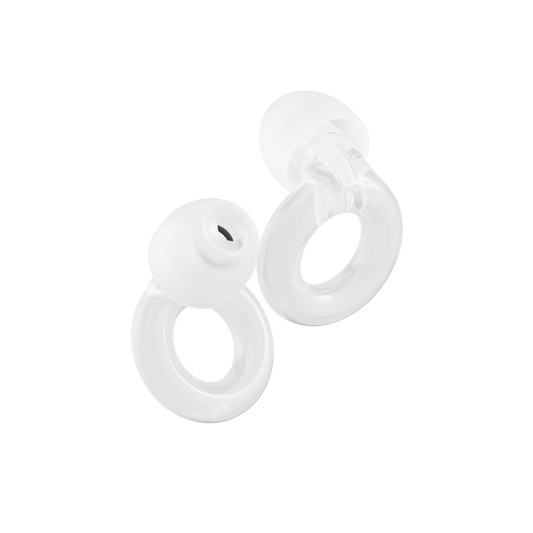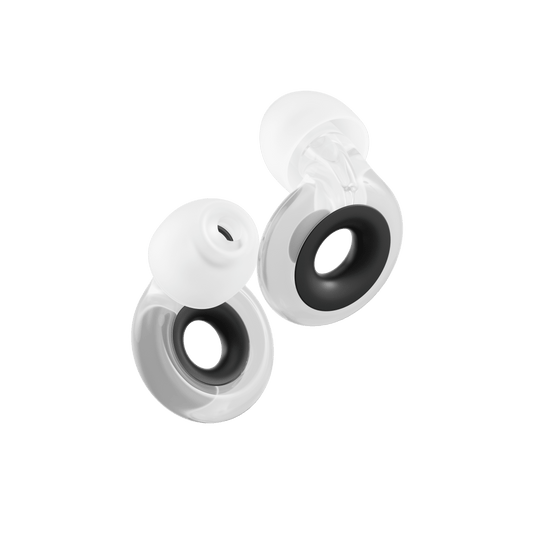Key takeaways
- Noise-induced hearing loss is really common – but it’s also really preventable
- If you spend any time in noisy environments, you should wear hearing protection
- There are several different types of ear protection to choose from, including foam earplugs, silicone earplugs and earmuffs
- Choose the right hearing protection for you based on cost, comfort and convenience
There are lots of reasons why people may seek out noise protection for their ears. Maybe you’re a music lover and go to lots of festivals and concerts. Perhaps you have a job in a noisy environment and need to wear protective hearing devices. Or maybe you’re sensitive to noise and don’t just want to protect your hearing, but also want to reduce overstimulation from loud environments.
Whichever category you fall into, hearing protection is important. That’s because loud noises can damage your hearing – and your overall health.
So, let’s take a look at the different types of hearing protection, and how to choose the hearing protection that works for you, whatever your needs.

Why is hearing protection important?
Noise-induced hearing loss is really common. Probably more common than you think. It’s thought to affect 26 million adults between the age of 20 and 69 worldwide, along with 5.2 million children.
And the worst part? It’s preventable.
Our ears are really sensitive to noise. There’s the possibility of hearing damage when exposed to sounds of 85 decibels, without any hearing protection, for eight hours. That’s roughly equivalent to a lawnmower (85 dB) or a noisy restaurant (88 dB). Unless you work in a restaurant, it’s unlikely that you’ll be exposed to noises of that level for that long.
But there is a strong possibility that you’ll be exposed to louder noises, at a music concert, for example. And the louder the noise, the less time it takes to damage your hearing. Concerts and festivals average 97 dB, while rock concerts are even louder, at 104 dB. Just 30 minutes of exposure to 97 dB without hearing protection could cause damage, while it could take just 7.5 minutes at 104 dB. So, a couple of songs from your favorite band could cause damage to your ears. Is it really worth it?
Exposure to loud noises can also cause other hearing problems, like tinnitus. If you’ve ever had a ringing in your ears after a concert, you’ll know what we mean by tinnitus. Sometimes, it goes away after a few hours, but in other cases – and often, with repeated exposure – it can become permanent.
Types of ear protection
Okay, so you know that protecting hearing is important. But what are the different types of hearing protection available? There are a few different options out there, so it’s important to find the right one for you.
Earplugs
Earplugs are inserted into your ear, and can be made of foam, silicone or wax. They can either be reusable or disposable, and there are two main types of earplugs: those that block sound out completely, and those that reduce the intensity of the sound waves entering the ear.
Custom-molded earplugs
Custom-molded earplugs are made by taking impressions of a person’s ear. They’re usually made from soft silicone and sit snugly inside the ear canal to block out noise.
Earmuffs
Earmuffs block out noise by completely covering the outer ear. They typically have a rigid outer shell made from hard plastic, with ear cups that are filled with sound-absorbing material like foam or fiber to reduce the intensity of sound waves that reach the ears.
Canal caps
Canal caps are similar to earplugs, but are joined together by a headband. This keeps the caps in place, meaning they can be worn around your neck. They can be more convenient for people who often have to take earplugs out and reinsert them again.
Noise-canceling headphones
Although they’re primarily designed for listening to music, noise-canceling headphones or earbuds can provide some level of hearing protection, using technology to cancel out external noise.
Let’s take a closer look at the pros and cons of the different options…
Types of earplugs
When it comes to earplugs, the main options are foam and silicone earplugs.
Foam earplugs
Standard foam earplugs are cheap and convenient. However, they’re also designed for one-time use. The foam they’re made from gets dirty easily, meaning they’re not very hygienic to reuse – and because they’re disposable, they’re also not very environmentally friendly.
They do tend to offer a good amount of noise reduction, but there’s one problem: they’re designed to block sound out. That might be fine if you’re working on a construction site, or doing a noisy sport, but if you’re at a music festival, you don’t want the sound to be muffled.
Finally, because foam earplugs come in one size, they’re not suitable for every ear shape and size. That means you might have to suffer a few hours of discomfort while wearing them.
Silicone earplugs
Silicone earplugs, like Loop Earplugs, combine an acoustic channel and a mesh, effectively reducing the volume of noise without distorting it. That means noise isn’t blocked out completely, just decreased in intensity without isolating you.
Plus, they’re reusable, meaning they’re good for your wallet and good for the environment. Pop them in the carry case and put them in your bag or attach to your keyring, and you’ll always have them to hand.
They also come with a selection of different ear tip sizes, so you can get the perfect fit for you. That means you can wear them all night long and still feel comfortable.
You can even get different earplugs designed for different situations. If you’re a music lover, for example, then Loop Experience will reduce the amount of noise (with up to 18 decibels of noise reduction) while still giving you a crisp and clear experience. If you’re sensitive to noise, then the Loop Engage takes the edge of environmental noise while ensuring you can still participate in conversations and be fully engaged with what’s going on around you.
10M+ happy customers
Our earplugs
Earmuffs
There are two options when it comes to earmuffs: standard and electronic.
Standard earmuffs
Standard earmuffs, sometimes known as hearing defenders, use a combination of acoustic materials and a seal around the ear cups to block out sound waves. They’re simple and easy to use, and offer good sound blocking. What’s more, they don’t need any complicated setup – simply wear them over the ears, and adjust the headband for a comfortable fit.
Plus, because they’re usually designed to be used for work and in outdoor settings, they’re built to last and can endure rough handling.
However, they really do block out a lot of sound – so that means they’re not suitable for some environments, like live music.
They’re also bulky, which means they’re not exactly the most convenient of options when it comes to hearing protection.
Electronic earmuffs
Electronic earmuffs incorporate advanced technology to offer additional features beyond noise reduction. They come with built-in microphones which means that the wearer can hear conversations and environmental sounds more clearly without compromising on their hearing protection.
Some electronic earmuffs also offer automatic noise cancellation, meaning they have the ability to instantly suppress or reduce sudden loud noises. Additionally, some also include two-way radio or Bluetooth connectivity so you can talk to other people nearby without having to move the earmuffs.
However, electronic earmuffs are more expensive than both standard earmuffs and earplugs. Plus, they need batteries or power sources – meaning they’re not a particularly portable option.
Custom-molded earplugs
Some standard earplugs can be uncomfortable, but because custom earplugs are specifically molded to your ears, they’re much more comfortable.
Because of their customized fit, these earplugs offer better noise reduction compared to one-size-fits all alternatives. They fit snugly in the ear, meaning they offer significant noise reduction, and are suitable for various environments including loud concerts and industrial work settings.
The major downside of custom earplugs is that they’re more expensive than off-the-shelf alternatives. The process is quite lengthy and expensive, including a professional consultation, ear impressions and making the ear plugs.
The other downside: your ears don’t stay the same shape and size throughout your life. That means you might need to get them adjusted, incurring even more expenses.
Choosing the right ear protection
So, what is the most effective hearing protection? It all comes down to your specific needs. Here’s how to choose the right earplugs, or alternative to earplugs, for you.
How much noise reduction do you need?
Firstly, consider what level of noise you’re going to be exposed to, and therefore how much noise reduction you need. If you work in a noisy environment or go to lots of loud concerts, you’ll need hearing protection that offers plenty of noise reduction. But if you’re in a moderately noisy environment, like an office or a noisy street, you may need less noise reduction.
How comfortable are they?
Comfort is another key factor. If you’re going to be wearing ear protection for extended periods, then you’ll want something super comfortable that won’t cause discomfort or irritation. Think about whether anything could make your hearing protection less comfortable – the headband on earmuffs may not be comfortable if you’re a glasses wearer, for example.
What’s your budget?
You might also want to think about cost. It’s tempting to go for the cheapest option, but your hearing is important – so more expensive hearing protection is worth the investment. Disposable foam earplugs are cheap, so if you only need to use them once, then they could be a great option.
But if you need to use them over and over again, the cost (and the impact on the environment) could add up. So think about your budget and how often you’ll have to use them, and strike a balance between cost and quality.
Do you need to be able to communicate?
Finally, it’s important to think about whether you need to be able to communicate while reducing noise. Electronic earmuffs include built-in options so you can still easily talk to others while protecting your ears, and some earplugs, like Loop Engage and Experience, filter noise rather than blocking it out, so you can still have a conversation.
Protect against noise with the right hearing protection
Protecting your hearing is important. That’s a fact. It’s just a case of choosing the right option for you. If you work on a construction site, industrial ear muffs might be the best option for you. If you like going to concerts and events, then earplugs that filter out noise will protect your hearing while still enjoying the experience.
Whatever you choose, they should be comfortable, and offer plenty of noise reduction. Then, it’s up to you to get out there and live life to the fullest – with added confidence that you’re protected from hearing damage.

Protect Your Ears: How to Prevent Hearing Damage
Whether you’re working in noisy environments or are exposed to noise in free time, it’s important to protect your ear...

What To Look For In Noise Reduction Earplugs
Unlock expert tips for choosing the perfect noise-reduction earplugs! Discover key features to consider when choosing...

How to choose the best earplugs for concerts
If you’re a live music fan, it’s essential to protect your ears at concerts. Find out how to choose the best earplugs...






















